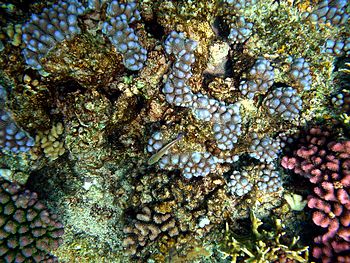Establishing the Basic Needs of the Tank
Everyone has admired the large saltwater aquariums that can be found in the offices of most dentists, physicians, cosmetologists and marine enthusiasts but have believed them to be far too much work to bring into their own homes. Fortunately, this is not the case. While the process of establishing a saltwater aquarium can be a costly one, in terms of manual labor there is a very simple method which almost guarantees success.
 |
| Corals. (Photo credit: Wikipedia) |
Step 1: Assemble and prepare the equipment. During packaging and production the aquarium and all of its corresponding parts have almost certainly been exposed to various pollutants, such as dust and chemicals, which will be very harmful to the fish if it is allowed free reign in the aquarium. Prior to use every piece of the aquarium should be washed with hot, fresh water and cleansed with a soft piece of cloth to prevent scratching.
Step 2: Place all of the components in the tank WITHOUT adding any of the decorative features. Then fill the tank to the fill line (which may or may not be already marked on the aquarium-2 to 3 inches from the top is generally adequate to prevent major spillover when the tank is cleaned or the fish fed) with saltwater (if you have chosen to make your own saltwater solution read below for instructions). Turn the tank on and allow it to run for 24 hours to ensure that all components are fully functional.
**Making Your Own Saltwater**
Ocean water is the natural habitat of all saltwater marine animals and, consequently, the best water source for any saltwater aquarium. If ocean water is not available, however, and the owner of a saltwater aquarium does not wish to purchase a pre-made saltwater solution it is possible to make saltwater. It is important to use a sea salt mixture that is free of impurities rather than table salt when creating saltwater in order to reproduce the natural environment as accurately as possible. These mixes can be purchased from any store that specializes in the sale of tropical fish.
Step 3: Landscape your aquarium. Organic substances are not only more aesthetically pleasing than their plastic counterparts, they provide a more pleasing environment for the fish as well. Keeping in mind that fish generally use what humans consider to be decorations as shelter when in the wild it is important to consider the types of fish which will be inhabiting the tank prior to choosing its decoration.
Step 4: Start the 30 day cycling process, during which the ammonia should be tested regularly. This can be done with or without fish in the tank.
Following these simple steps will allow the amateur marine enthusiast to place aside their fears and enjoy the benefits of a happy, healthy aquarium in the privacy of their own home.


No comments:
Post a Comment